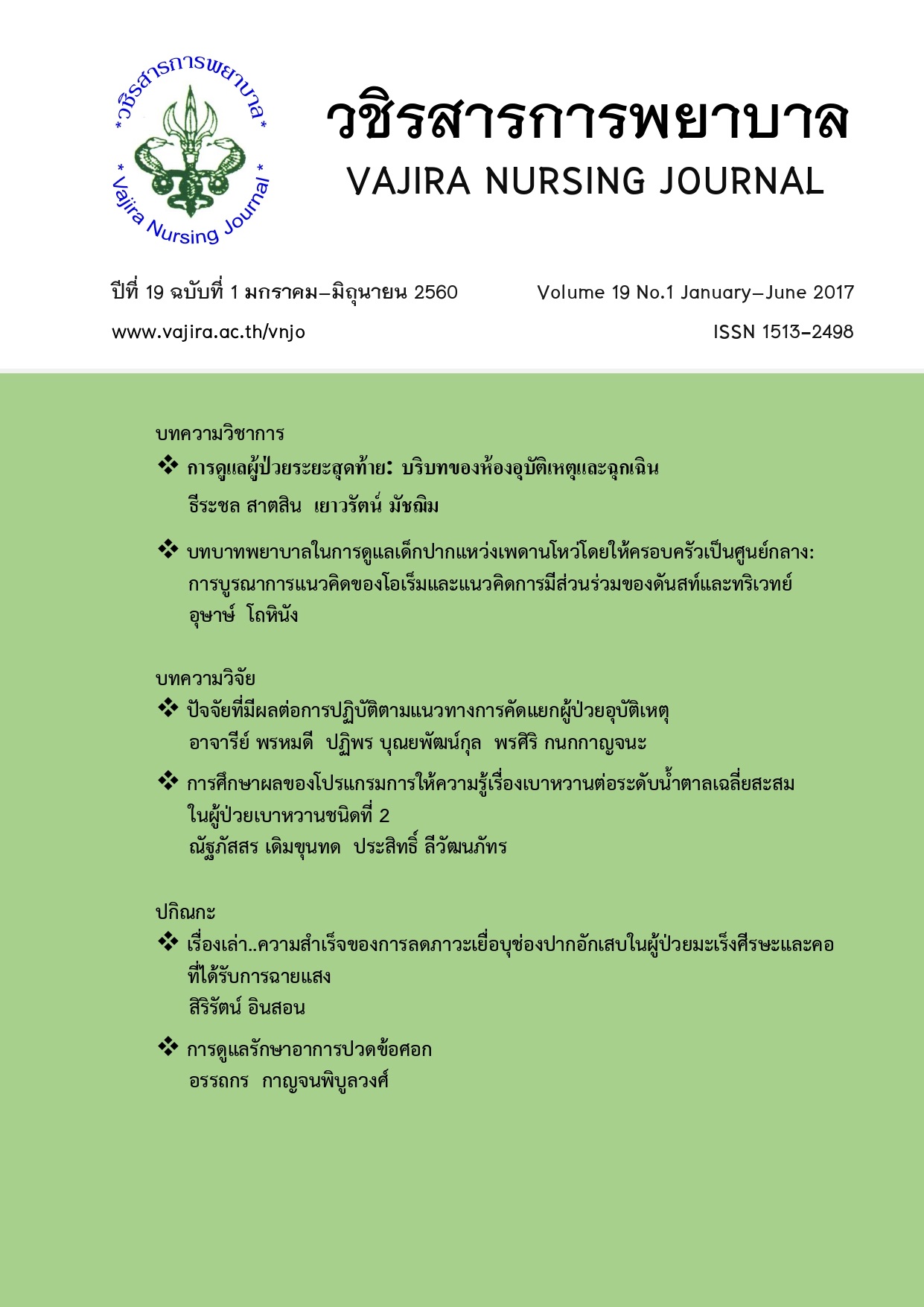การศึกษาผลของโปรแกรมการให้ความรู้เรื่องเบาหวาน ต่อระดับน้ำตาลเฉลี่ยสะสมในผู้ป่วยเบาหวานชนิดที่ 2
Main Article Content
บทคัดย่อ
การวิจัยครั้งนี้เป็นการศึกษาแบบทบทวนเวชระเบียนย้อนหลัง เพื่อศึกษาผลการเปรียบเทียบระดับน้ำตาลเฉลี่ยสะสมและผลลัพธ์ทางด้านสุขภาพของผู้ป่วยเบาหวานชนิดที่ 2 ก่อนและหลังเข้าร่วมโปรแกรมให้ความรู้เรื่องเบาหวาน 3 เดือน ตั้งแต่วันที่ 1 มกราคม 2557 ถึงวันที่ 31 ธันวาคม 2557 กลุ่มตัวอย่างเป็นผู้ป่วยเบาหวานชนิดที่ 2 ที่เข้ารับบริการที่ศูนย์เบาหวาน คณะแพทยศาสตร์วชิรพยาบาล มหาวิทยาลัยนวมินทราธิราช จำนวน 60 คน เครื่องมือที่ใช้คือ โปรแกรมการความรู้เรื่องเบาหวาน ประกอบด้วย ความรู้เรื่องโรคเบาหวาน ภาวะแทรกซ้อน อาหาร การใช้ยา การออกกำลังกาย การดูแลเท้า การประเมินควบคุมเบาหวานด้วยตนเอง การติดตามระดับน้ำตาลในเลือด การสังเกตอาการผิดปกติด้วยตนเอง และการแก้ไขภาวะฉุกเฉินเช่นน้ำตาลในเลือดต่ำ วิเคราะห์ข้อมูลโดยใช้สถิติเชิงพรรณนาและทดสอบความแตกต่างค่าเฉลี่ยของกลุ่มตัวอย่าง 2 กลุ่ม ไม่อิสระ
กลุ่มตัวอย่างส่วนใหญ่เป็นเพศหญิงร้อยละ 63.3 โดยมีอายุเฉลี่ย 59.95+12.61 ปี และระยะเวลาการเป็นเบาหวานเฉลี่ย 16.43+9.09 ปี ระดับน้ำตาลเฉลี่ยสะสม น้ำหนักตัว ระดับน้ำตาลหลังอดอาหาร 8 ชั่วโมง ระดับโคเลสเตอรอลและเอชดีแอล ก่อนและหลังให้โปรแกรมความรู้เรื่องเบาหวานมีความแตกต่างกัน (p <0.05) ระดับความดันซีสโตลิค ไดแอสโตลิค ไตรกลีเซอร์ไรด์ และค่าอัตราการกรองของไต ก่อนและหลังให้โปรแกรมความรู้เรื่องเบาหวานไม่มีความแตกต่างกัน
การให้โปรแกรมความรู้เรื่องโรคเบาหวาน เป็นประโยชน์ต่อการควบคุมโรคเบาหวาน สามารถลดระดับน้ำตาลเฉลี่ยสะสม ภายหลังติดตาม 3 เดือน และช่วยให้ผลลัพธ์ทางด้านสุขภาพอื่นๆดีขึ้น อย่างไรก็ตาม ผู้ป่วยควรได้รับโปรแกรมความรู้อย่างต่อเนื่อง ระยะยาวและมีการติดตามผลลัพธ์อย่างต่อเนื่อง
Article Details
เนื้อหาและข้อมูลในบทความที่ลงตีพิมพ์ในวชิรสารการพยาบาลถือเป็นข้อคิดเห็นและความรับผิดชอบของผู้เขียนบทความโดยตรง ซึ่งกองบรรณาธิการไม่จำเป็นต้องเห็นด้วย หรือร่วมรับผิดชอบใด ๆ ทั้งสิ้น
บทความ ข้อมูล เนื้อหา รูปภาพ ฯลฯ ที่ได้รับการตีพิมพ์ในวชิรสารการพยาบาล ถือเป็นลิขสิทธิ์ของวชิรสารการพยาบาล หากบุคคลใดหรือหน่วยงานใดต้องการนำทั้งหมดหรือส่วนหนึ่งส่วนใดไปเผยแพร่ต่อหรือเพื่อกระทำการใด ๆ จะต้องได้รับอนุญาตเป็นลายลักอักษรจากวชิรสารการพยาบาลก่อนเท่านั้น
เอกสารอ้างอิง
2. จรณิต แก้วกังวาล และ ประตาป สิงหศิวานนท์. (2554). ขนาดกลุ่มตัวอย่างในการวิจัยทางคลินิก. ใน พรรณี ปิติสุทธิธรรม และ ชยันต์ พิเชียรสุนทร (บรรณาธิการ). ตำราการวิจัยทางคลินิก (pp. 107-143). กรุงเทพมหานคร: บริษัทอมรินทร์พริ้นติ้งแอนด์พับลิชชิ่ง.
3. นันนภัส พีระพฤฒิพงศ์, นํ้าอ้อย ภักดีวงศ์, อำภาพร นามวงศ์พรหม. (2556). ผลของโปรแกรมการจัดการดูแลตนเองต่อความรู้กิจกรรมการดูแลตนเองและค่าฮีโมโกลบินที่มีนํ้าตาลเกาะในผู้เป็นเบาหวานชนิดที่ 2. วารสารสมาคมพยาบาล สาขาภาคตะวันออกเฉียงเหนือ, 30:98-105.
4. นุชรี อาบสุวรรณ, นิตยา พันธุเวทย์. (2557). ประเด็นสารรณรงค์วันเบาหวานโลกปี 2556. สำนักโรคไม่ติดต่อ. ที่มา http://www.thaincd.com/information-statistic/non-communicable-disease-data.php.
5. บุญจันทร์ วงศ์สุนพรัตน์, ฉัตรประอร งามอุโฆษ, น้ำเพชร สายบัวทอง. (2551). การควบคุมระดับน้ำตาลใน เลือดของผู้เป็นเบาหวาน ภายหลังเข้าโครงการอบรมความรู้การจัดการเบาหวานด้วยตนเองแบบกลุ่ม. รามาธิบดีพยาบาลสาร, 14:289-297.
6. ปกาสิต โอวาทกานนท์, วิริยา สุนทรา. (2555). ผลของโปรแกรมการให้ความรู้การดูแลตนเองในผู้ป่วย โรคเบาหวานชนิดที่ 2 แบบกลุ่มในโรงพยาบาลทรายมูล. ศรีนครินทร์เวชสาร, 27:236-241.
7. พัชราภรณ์ อารีย์, อุมาพร ปณญโสพรรณ, วิจิตร ศรีสุพรรณ, สถิต วงศ์สุรประกิต. (2556). ผลของรูปแบบ การปรับเปลี่ยนพฤติกรรมการกินต่อระดับไขมันและน้ำตาลในเลือดในสตรีที่มีภาวะไขมันในเลือดสูง. พยาบาลสารปีที่ 40, ฉบับพิเศษ:14-22.
8. พัชรี อ่างบุญตา, ลินจง โปธิบาล, ณัฐพงศ์ โฆษชุณหนันท์. (2555). ผลของโปรแกรมสนับสนุนการจัดการ ตนเองต่อพฤติกรรมการจัดการตนเองและระดับฮีโมโกลบินเอวันซีของผู้สูงอายุที่เป็นโรคเบาหวานชนิดที่ 2. พยาบาลสาร, 39: 93-104.
9. สถาบันวิจัยและประเมินเทคโนโลยีทางการแพทย์ กรมการแพทย์ กระทรวงสาธารณสุข. (2553). การให้ความรู้เพื่อจัดการโรคเบาหวานด้วยตนเอง. พิมพ์ครั้งที่ 2. กรุงเทพมหานคร: ชุมชนสหกรณ์การเกษตรแห่งประเทศไทย จำกัด.
10. สมพงษ์ สุวรรณวลัยกร. (2551). เอกสารการให้ความรู้เกี่ยวกับโรคเบาหวาน. กรุงเทพมหานคร: สำนักงานหลักประกันสุขภาพแห่งชาติ.
11. สมาคมโรคไตแห่งประเทศไทย และ สำนักงานหลักประกันสุขภาพแห่งชาติ. (2555). คู่มือการจัดการการดูแลผู้ป่วยโรคไตเรื้อรังระยะเริ่มต้น. กรุงเทพมหานคร: บริษัทยูเนียนอุลตร้าไวโอเร็ต จำกัด
12. American Diabetes Association. (2015). Standards of medical care in diabetes-2015 abridged for primary care providers. Clin Diabetes, 33(2), 97-111. doi:10.2337/diaclin.33.2.97
13. Chen, C. C., & Cheng, S. H., (2011). Better continuity of care reduces costs for diabetic patients. The American Journal of Managed Care, 17 (6) 420-427.
14. Delamater, A.M., (2006). Clinical Use of Hemoglobin A1c to Improve Diabetes Management. Clinical diabetes. 24(1), 6-8.
15. Norris, S.L., Engelgau, M.M., Narayanan, K.V. (2001). Effectiveness of self-management training in type 2 diabetes: a systemic review of randomized controlled trial. Diabetes care, 24:561-587.
16 Shaw, J. E., & Chisholm, D. J. (2003). 1: Epidemiology and prevention of type 2 diabetes and the metabolic syndrome. Med J Aust, 179(7), 379-383.
17. Stratton, I. M., Adler, A. I., Neil, H. A., Matthews, D. R., Manley, S. E., Cull, C. A., . . . Holman, R. R. (2000). Association of glycaemia with macrovascular and microvascular complications of type 2 diabetes (UKPDS 35): prospective observational study. BMJ, 321(7258), 405-412.
18. World Health Organization. (2006). Definition and diagnosis of diabetes mellitus and intermediate hyperglycemia: Report of a WHO/IDf ConsultatIon. Geneva: Switzerland.
19. Wild S., Roglic G., Green A., Sicree R., King H. (2004). Global prevalence of diabetes estimates for the year 2000 and projection for 2030. Diabetes care, 27:1047-


